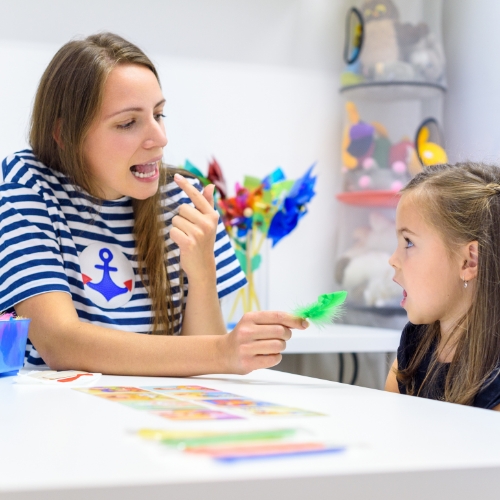
What are speech sound disorders?
Most children make some mistakes as they learn to say new words. A speech sound disorder occurs when mistakes continue past a certain age. Every sound has a different range of ages when the child should make the sound correctly. Speech sound disorders include problems with articulation (making sounds) and phonological processes (sound patterns).
What are some signs of an articulation disorder?
An articulation disorder involves problems making sounds. Sounds can be substituted, left off, added or changed. These errors may make it hard for people to understand you.
Young children often make speech errors. For instance, many young children sound like they are making a “w” sound for an “r” sound (e.g., “wabbit” for “rabbit”) or may leave sounds out of words, such as “nana” for “banana.” The child may have an articulation disorder if these errors continue past the expected age.
Not all sound substitutions and omissions are speech errors. Instead, they may be related to a feature of a dialect or accent. For example, speakers of African American Vernacular English (AAVE) may use a “d” sound for a “th” sound (e.g., “dis” for “this”). This is not a speech sound disorder, but rather one of the phonological features of AAVE.
To see the age range during which most children develop each sound, visit www.talkingchild.com/speechchart.html.
What are some signs of a phonological disorder?
A phonological process disorder involves patterns of sound errors. For example, substituting all sounds made in the back of the mouth like “k” and “g” for those in the front of the mouth like “t” and “d” (e.g., saying “tup” for “cup” or “das” for “gas”).
Another rule of speech is that some words start with two consonants, such as broken or spoon. When children don’t follow this rule and say only one of the sounds (“boken” for broken or “poon” for spoon), it is more difficult for the listener to understand the child. While it is common for young children learning speech to leave one of the sounds out of the word, it is not expected as a child gets older. If a child continues to demonstrate such cluster reduction, he or she may have a phonological process disorder.
How are speech sound disorders diagnosed?
A speech-language pathologist (SLP) is the professional that evaluates children or adults with speech and language difficulties. The SLP listens to the person and may use a formal articulation test to record sound errors. An oral mechanism examination is also done to determine whether the muscles of the mouth are working correctly. The SLP may recommend speech treatment if the sound is not appropriate for the child’s age or if it is not a feature of a dialect or accent. For children, the SLP often also evaluates their language development to determine overall communication functioning.
What treatments are available for people with speech sound disorders?
SLPs provide treatment to improve articulation of individual sounds or reduce errors in production of sound patterns. Articulation treatment may involve demonstrating how to produce the sound correctly, learning to recognize which sounds are correct and incorrect, and practicing sounds in different words. Phonological process treatment may involve teaching the rules of speech to individuals to help them say words correctly.
What causes speech sound disorders?
Many speech sound disorders occur without a known cause. A child may not learn how to produce sounds correctly or may not learn the rules of speech sounds on his or her own. These children may have a problem with speech development, which does not always mean that they will simply outgrow it by themselves.
Many children do develop speech sounds over time but those who do not often need the services of an SLP to learn correct speech sounds.
Some speech sound errors can result from physical problems, such as:
- Developmental Disorders (e.g., Autism)
- Genetic Syndromes (e.g., Down Syndrome)
- Hearing Loss
- Illness
- Neurological Disorders (e.g., Cerebral Palsy)
Children who experienced frequent ear infections when they were young are at risk for speech sound disorders if the ear infections were accompanied by hearing loss.
How common are speech sound disorders?
In young children learning to speak, speech sound errors are quite common. In fact, very few children develop speech without producing errors early on. By the age of 8, children should be able to produce all sounds in English correctly.
Your Next Steps…
Request An Appointment
Receive A Custom Treatment Plan
Work Hard and Progress In Your Recovery
Recover & Enjoy Life Pain-Free!


